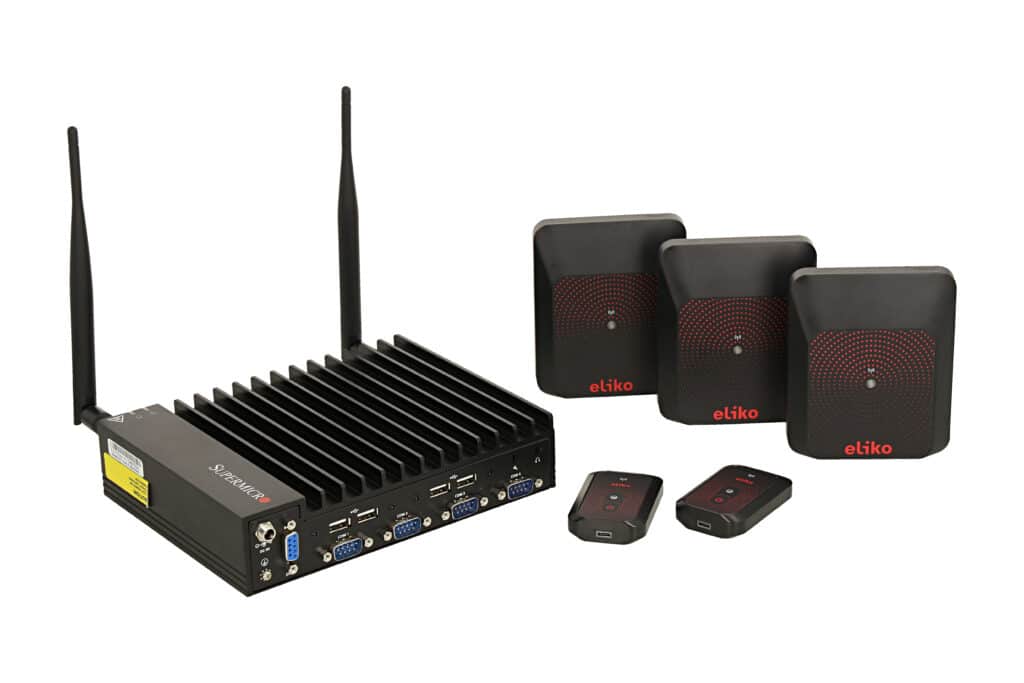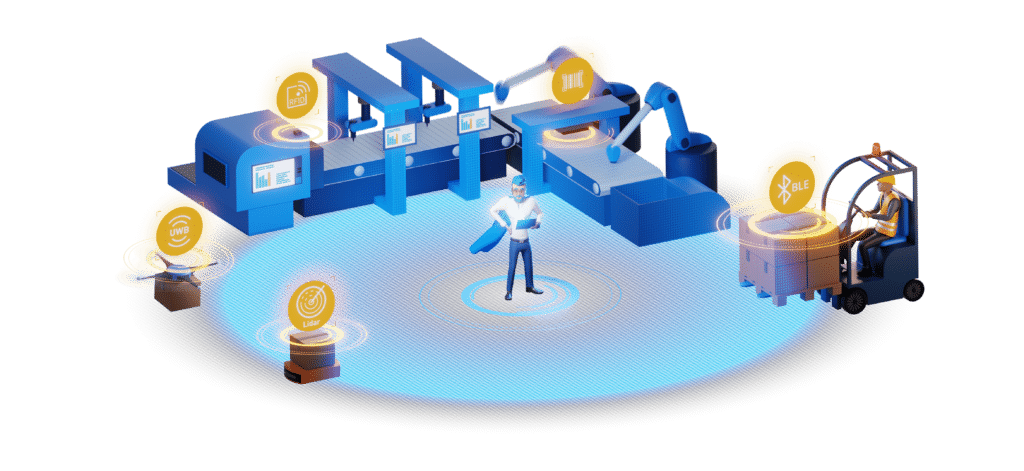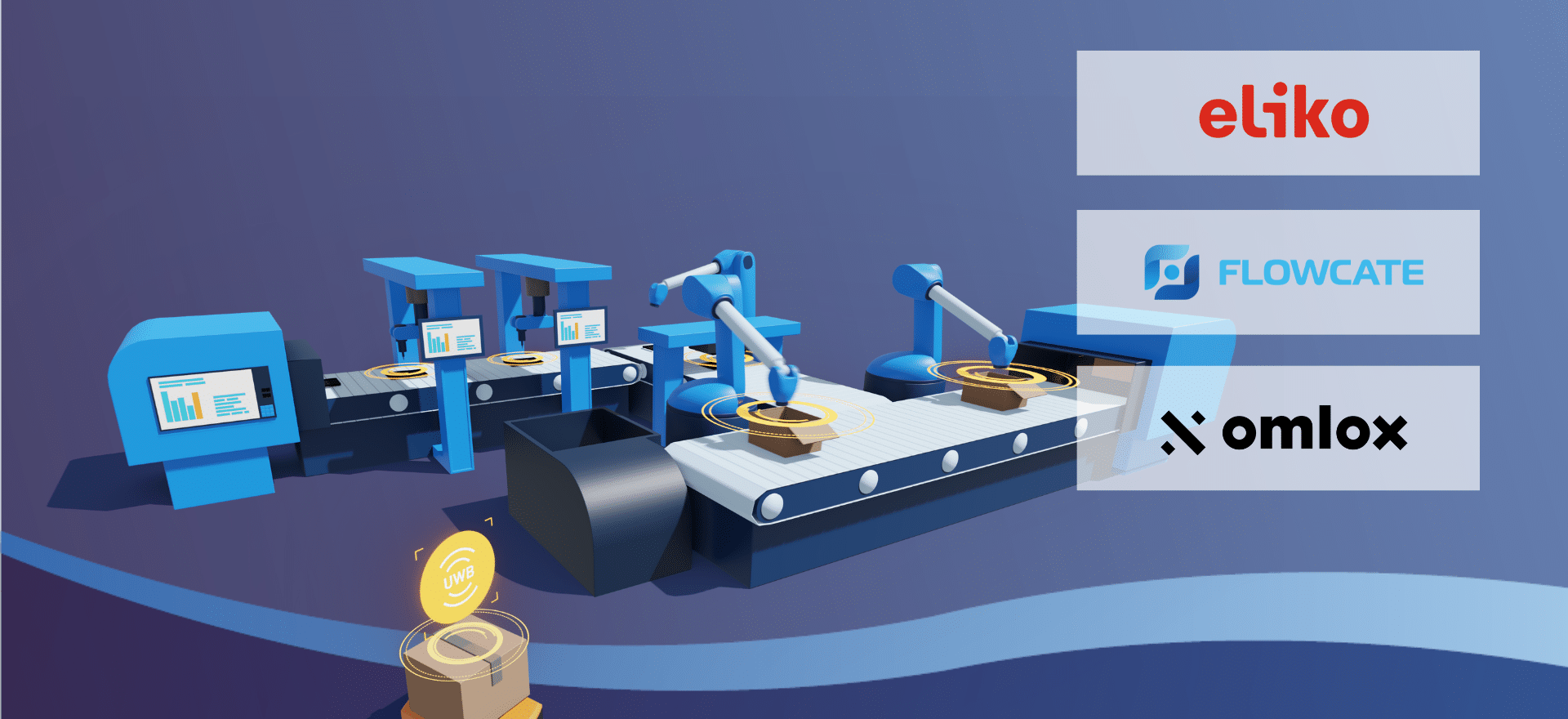In industrial environments, visibility is everything — especially when it comes to knowing exactly where tools, materials, and work-in-progress are at any given moment. Whether you’re tracking heavy equipment, managing time-sensitive workflows, or validating production steps, accurate location data is key to driving automation, safety, and efficiency.
While there are many technologies out there that promise real-time location tracking, UWB has emerged as the gold standard for sub-meter precision. But even among UWB systems, not all solutions are created equal, and that’s exactly where our partner Eliko stands out.
In this article, we explore why high-precision tracking is critical in certain industrial use cases, how Eliko’s unique hybrid UWB approach delivers reliable accuracy even in challenging environments, and how DeepHub® enables seamless integration with other location technologies for a future-proof, interoperable setup.
Why UWB Is Built for Industrial Environments
UWB works by sending ultra-short radio pulses and calculating either their time-of-flight (ToF) or time-difference-of-arrival (TDoA) to determine location. This allows for positioning accuracies down to 10–30 cm, even in spaces full of metal machinery, moving equipment, and signal reflections.
These are exactly the environments where narrow-band technologies like BLE or RFID often fail. Multipath interference from metal structures can corrupt signal quality and lead to unreliable tracking. UWB, with its nanosecond-level timing precision, isolates direct paths from reflections, ensuring stable and accurate positioning.
But even standard UWB systems can struggle when anchor placement is constrained or synchronization across anchors is difficult. Long walls, obstructed lines of sight, or a lack of power and networking infrastructure in certain zones can all degrade performance.
That’s where Eliko’s proprietary hybrid protocol stands out. Their Active-Passive Two-Way Ranging (AP-TWR) approach combines the strengths of both ToF and TDoA while eliminating many of their weaknesses. It enables:
- Asymmetric anchor layouts — no need for perfect coverage from all sides
- No tight synchronization requirements — simplifies deployment and reduces cost
- Multiple micro-exchanges per cycle — for better positioning resilience, even with reflections or interference
All of this is built in-house, from hardware to firmware, and field-tested in harsh industrial environments. The result is a robust and flexible system that delivers accurate positioning even where traditional UWB would fall short.
In short: Eliko’s hybrid protocol makes high-precision RTLS viable in places where most systems hit a wall — literally.
When <50 cm Accuracy Really Matters
While zone-level tracking works for many basic applications, some factory processes demand much higher precision — especially when automation or safety is involved. Eliko has identified several key use cases where sub-50 cm accuracy isn’t just nice to have — it’s mission-critical:
- Work-cell process and cycle monitoring: Understand exactly how long each item spends in each tightly packed production zone — essential for optimizing takt times and identifying process delays.
- Automatic warehouse management: Track the flow of WIP and material by localizing the carriers (like forklifts or cranes) rather than every individual item — improving efficiency without massive tag overhead.
- Automated tool enablement: Energize torque tools only when they’re within the correct zone — and tie every torque event directly to the product ID for traceability and quality control.
- Robot and AGV/AMR fleet management: Use high-accuracy positioning as the foundation for collision avoidance, mission planning, and shared space coordination.
- Crane, hoist, and forklift positioning for safety: Enforce dynamic safety zones — slowing down equipment near people or logging exact positions for near-miss analysis.
- Assembly sequencing and kitting: Eliminate line-miss errors by confirming the precise location and pick sequence of kit bins in dense layouts.
- WIP genealogy for quality control: Monitor the real-time process sequence for each item, trigger alerts when cycle times exceed thresholds, and analyze workstation congestion.
Across all of these applications, Eliko’s UWB system consistently avoids the false positives and negatives that can undermine automation, drive up costs, or compromise safety.

UWB Positioning in Smart Manufacturing at Work: The Krah Pipes Case
A powerful example of UWB’s impact comes from Krah Pipes, a leading manufacturer of large-diameter thermoplastic pipes. Their production process involves high temperatures and massive steel mandrels, making tracking particularly difficult. Previous attempts using RFID, cameras, or vision systems simply didn’t work due to heat, interference, or line-of-sight constraints.
Eliko deployed a UWB system using heat-resistant, IP67-rated tags on the mandrels and critical tools. Anchors were placed throughout the facility to create location zones that correspond to each stage of the production process. The results were immediate:
- Production steps are now automatically triggered based on location
- Material and energy consumption is logged per individual pipe
- Manual data entry is eliminated, reducing operator workload and error
- Quality issues can be traced back to specific times and process steps
What used to be a blind spot in operations is now a rich stream of live data — enabling accurate costing, hands-free automation, and better decision-making on the shop floor.
Overcoming Harsh Layouts and Limited Visibility
One of the biggest challenges at Krah was anchor placement. Due to the factory layout, all UWB anchors had to be mounted on a single wall, creating significant visibility and geometry limitations.
This is where Eliko’s hybrid protocol proved its value. Unlike traditional systems that require tightly synchronized anchors or clear lines of sight, Eliko’s Active-Passive Two-Way Ranging (AP-TWR) protocol:
- Works with asymmetric anchor layouts
- Doesn’t require anchor sync
- Allows multiple micro-exchanges per positioning cycle
- Provides accurate tracking even in metal-dense, obstructed spaces
Despite these constraints, the system still achieved ~30 cm accuracy — more than enough to support automated triggers and process validation across the entire floor.
Plug-and-Play Interoperability Through DeepHub®
Eliko’s UWB RTLS is now officially certified as DeepHub® Connected — meaning it integrates seamlessly into Flowcate’s omlox-compliant middleware. This unlocks seamless compatibility with a wide range of tracking technologies, allowing manufacturers to combine UWB’s precision with complementary tools like BLE for zone-level coverage or RFID for automated identification.
And that flexibility matters.
No factory floor is uniform. Some zones require centimeter-level accuracy to enable automation or enforce safety. Others only need coarse-grained visibility or ID checkpoints. DeepHub® abstracts away the technical differences between systems — unifying location data, standardizing APIs, and enabling real-time orchestration across vendors and technologies.
It’s not about choosing one locating technology. It’s about choosing the right mix — and having a middleware backbone that brings it all together, without compromise.

Key Takeaways on UWB Positioning in Smart Manufacturing
UWB is no longer an emerging technology — it’s a proven solution for delivering sub-meter precision, even in the harshest industrial settings.
Eliko’s hybrid UWB protocol stands out for its robustness in real-world conditions. Paired with our DeepHub® middleware, this creates a future-proof foundation for orchestrating real-time positioning across technologies, vendors, and environments.
We’re enabling manufacturers to achieve visibility, precision, and scalability — even where traditional systems fall short.
Let’s talk about how DeepHub® and Eliko can bring location intelligence to your operations.
